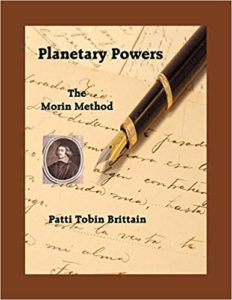Patti Tobin Brittain’s book, Planetary Powers: The Morin Method takes the reader through the first steps in understanding how her teacher, Gerhard Houwing and his accomplished source, Jean-Baptiste Morin (1583–1656), may have interpreted a horoscope. As I have a background in this method myself, it was fascinating to see her approach.
This is a clear introductory text that focuses on what the author calls “cause and effect.” Brittain uses stripped-down charts with only a few key elements to show how the ruler of one house placed in another creates meaning. She provides numerous examples to familiarize the reader with these mechanics, almost like drills. They are often illuminating, but it can be unclear whether the examples represent real people or theory.
Another important concept is “analogy.” The Sun has an affinity for the 10th house, and Venus for the 7th, for example. These will vary by sign, ruler, house or aspect and are also clearly illustrated. This is another concept that I had personally absorbed but never reviewed in such detail.
The planets’ essential nature (their basic meanings and whether malefic or benefic) are significant, as is cosmic state (dignities and debilities). Morin used simplified triplicity rulers (different than those in Ptolemy or William Lilly).
Students interested in Morin’s methods should find this book a good, accessible starting point. Houwing emphasized “the concise, the specific, the concrete” and a “systematic approach to reading a chart.” These do reflect Morin’s traditional practices, which are very different from modern psychological astrology.
Houwing “felt it was worse to be unresolute than to be wrong” and Brittain admits this “may sound fatalistic.” I found it so myself when one of her “malefic” examples reflected components of my own chart! I personally strive to be accurate in a more general way than rigorously specific, as the latter can often be misleading, judgmental, or just plain wrong. Horoscopes, like human beings, are complex.
Some intriguing tidbits are mentioned but not addressed and are certainly beyond the scope of the book. But I would’ve liked to read more about what factors could indicate events in childhood, middle or late life, or what placements might show experiences that are fleeting vs. constant and ongoing, for example.
Patti Tobin Brittain died in March of 2019 at the age of 91. Born on 10/28/27 in Forney, Texas, she had the Sun, Moon, Mercury and Mars all in Scorpio in a grand trine with Jupiter in Pisces and Pluto. Her mentor Houwing was born on 10/27/23 – just a day and four years before Brittain, so we can understand their connection astrologically. They share the Sun and Venus in Scorpio and both appear to have been single-minded and incisive. Houwing’s Jupiter closely conjoins Brittain’s Mercury, and he passed along his knowledge and experience to her. But while the teacher had Mercury sextile Neptune, the student had a square between these planets, so something may have been lost in this rendition of Houwing and Morin’s work.
Taking apart a horoscope to understand its working parts may be valuable, but putting an emphasis on isolated elements makes for a somewhat linear and literal approach. Another book is needed to fill in the vast spaces between the simplified examples shown and an interpretation and synthesis of the full horoscopes presented at the end of the book. Nevertheless, Planetary Powers provides a valuable introduction to Morin’s methods.
Check out Planetary Powers (AFA, 2010) on Amazon.com
(About my Amazon links)
Brittain’s birth date is from her obituary.
Houwing’s birth date is from public records on Ancestry.com
